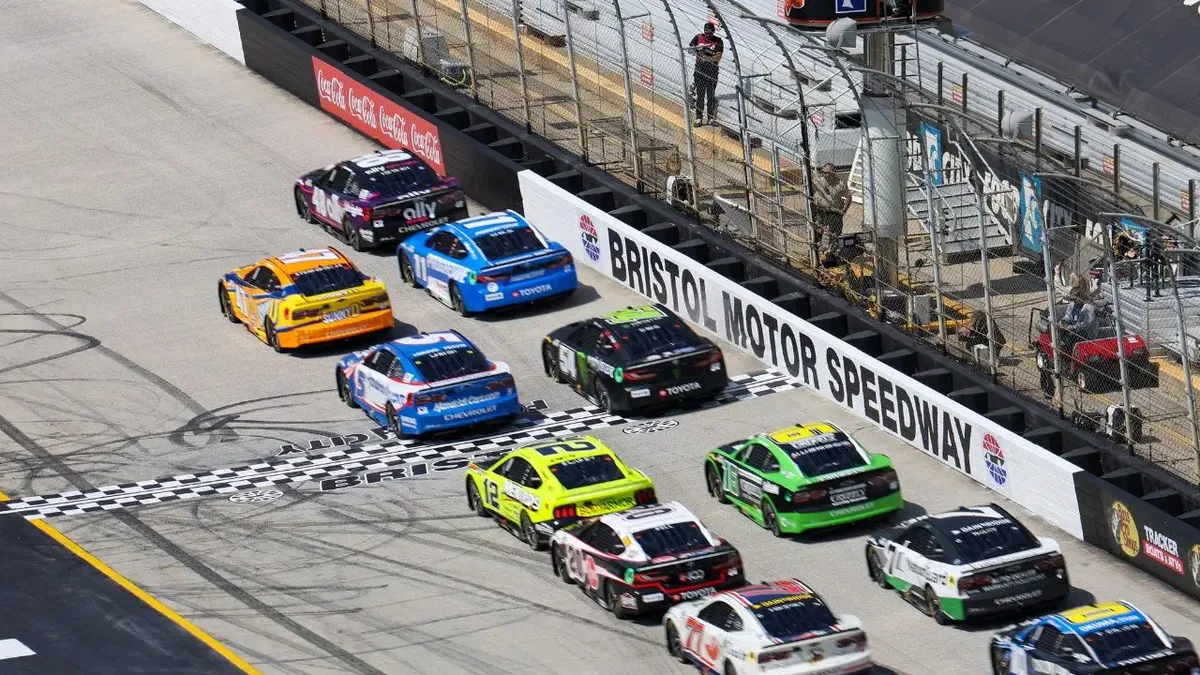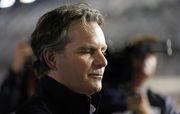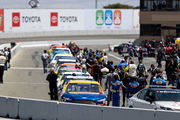

The Bass Pro Shops Night Race at Bristol Motor Speedway delivered a classic short-track spectacle, paying homage to NASCAR’s roots. Christopher Bell’s clutch victory—charging from fifth to first in the final four laps—capped a wild night featuring 14 cautions, 36 lead changes, and a tire strategy shake-up that kept everyone on edge. Goodyear’s softer right-side tire, engineered for rapid wear, transformed the half-mile bullring into a tactical battleground where drivers had to balance speed with preservation.
Watch What’s Trending Now!
This was no ordinary Bristol brawl; it set a new benchmark for short-track racing’s future. The unexpectedly fast tire wear turned the race into a complex strategic chess match, where passing, lane choice, and pit timing played as big a role as raw talent. NASCAR’s midweek approval of an additional tire set—the so-called “Great Goodyear Bailout”—acknowledged the extreme wear that blindsided teams.
Unlike recent dull, follow-the-leader short-track races, NASCAR officials such as managing director Brad Moran applauded the bold experiment as a move toward the intense, unpredictable racing fans crave.
ADVERTISEMENT
NASCAR’s vision for short-track glory
Brad Moran didn’t hold back in praising the impact of Bristol’s tire situation. “We want tires to wear out. We want big numbers in passing. We want different leaders throughout a race, and I think the majority of people want that. It’s a real science to try to get all that put together exactly. You know how it should be, but we certainly want some tire management in there,” he said during an interview with Sirius XM.
Goodyear’s softer right-side tire delivered exactly that, breaking down faster than expected and forcing teams to rethink their pit strategies and driving styles. The addition of an extra tire set mid-race kept the competition fierce, resulting in 14 cautions and a frantic pace as crews stretched their allocations. Moran’s vision of strategy-driven racing came to life, perfectly exemplified by Christopher Bell’s timely late pit stop for fresh tires that secured him a win over teammates running long on older rubber.
ADVERTISEMENT
🗣️ “It’s a real science to try get all that put together.”
🏟️ #NASCAR‘s Brad Moran details what the sanctioning body is looking for when racing at @ItsBristolBaby.
More –> https://t.co/MKhd9eLpQA pic.twitter.com/tTURaMXfqj
— SiriusXM NASCAR Radio (Ch. 90) (@SiriusXMNASCAR) September 16, 2025
Moran added, “We want two- and three-wide racing. We got that at Bristol. It might have involved a bit of luck with track conditions, but there’s no doubt we’re moving in the right direction. Short track fans wanted more action, and I think we delivered on that Saturday night.”
ADVERTISEMENT
Bristol delivered an electrifying display with 36 lead changes and intense multi-groove racing, fueled by track preparations such as PJ1 and aggressive tire wear that kept fans on the edge of their seats. Drivers boldly went two- and three-wide on restarts, highlighted by Christopher Bell’s savvy inside-lane dive and Brad Keselowski’s classic bump-and-run maneuver—both made possible by the softer tire compound that opened up new passing opportunities.
Supported by NASCAR’s surface adjustments, Brad Moran’s vision transformed Bristol into a masterclass of short-track racing, setting a dynamic precedent for upcoming venues like Martinsville and Richmond.
Top Stories
Dale Earnhardt’s Grandson’s NASCAR Future Remains Unhindered Despite Major Team Rebranding Ahead of 2026

Richard Childress’ Champion Driver Joins Forces with HMS Crew Chief to Make Last Minute Chili Bowl Entry

Jeff Gordon’s NASCAR Rival Issues Public Verdict Years After His Apology

Cup Legend to Step Down From His Role as NASCAR Organization Names New Executive Leader

Ross Chastain Recalls the Relentless Grind That Kept His NASCAR Dream Alive After Sponsorship Spin-off

ADVERTISEMENT
Bell’s take on Bristol’s wild swings
Christopher Bell, fresh from his thrilling Bristol victory, reflected on just how unpredictable the track has become. “Going into spring 2025 practice, we saw extreme tire wear again. Everyone came prepared to manage tires all weekend, but then the race played out normally. The fall 2025 practice was normal too, even with a tire designed to wear more—but the race turned chaotic. You never know what to expect at Bristol,” Bell told NASCAR’s The Day After.
The 2024 spring race had been dominated by tire wear, while last fall’s Night Race ran smoothly. In stark contrast, the fall 2025 race shocked everyone as softer tires and cooler temperatures triggered fast-paced chaos, catching even Bell’s Joe Gibbs Racing team off guard.
He went on, “We knew going in that the tire change was intended to increase wear, so we prepared for that. But the extreme level of wear—14 cautions and a shuffled running order—was beyond expectations.” Bell’s well-timed late pit stop for fresh tires became the key advantage over others sliding on worn rubber, proving crucial to his victory.
ADVERTISEMENT
Looking ahead to Loudon, which features grippier, high-fall-off tires, Bell’s current momentum paired with NASCAR’s thoughtful short-track tweaks could keep the excitement burning, proving the so-called “Great Goodyear Bailout” was only the beginning.
ADVERTISEMENT
ADVERTISEMENT
ADVERTISEMENT

